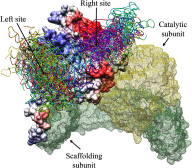Structure- and modeling-based identification of the adenovirus E4orf4 binding site in the protein phosphatase 2A B55α subunit
- PMID: 23530045
- PMCID: PMC3650409
- DOI: 10.1074/jbc.M112.343756
Structure- and modeling-based identification of the adenovirus E4orf4 binding site in the protein phosphatase 2A B55α subunit
Abstract
Background: The adenovirus E4orf4 protein must bind protein phosphatase 2A (PP2A) for its functions.
Results: The E4orf4 binding site in PP2A was mapped to the α1,α2 helices of the B55α subunit.
Conclusion: The E4orf4 binding site in PP2A-B55α lies above the substrate binding site and does not overlap it.
Significance: A novel functional significance was assigned to the α1,α2 helices of the PP2A-B55α subunit. The adenovirus E4orf4 protein regulates the progression of viral infection and when expressed outside the context of the virus it induces nonclassical, cancer cell-specific apoptosis. All E4orf4 functions known to date require an interaction between E4orf4 and protein phosphatase 2A (PP2A), which is mediated through PP2A regulatory B subunits. Specifically, an interaction with the B55α subunit is required for induction of cell death by E4orf4. To gain a better insight into the E4orf4-PP2A interaction, mapping of the E4orf4 interaction site in PP2A-B55α has been undertaken. To this end we used a combination of bioinformatics analyses of PP2A-B55α and of E4orf4, which led to the prediction of E4orf4 binding sites on the surface of PP2A-B55α. Mutation analysis, immunoprecipitation, and GST pulldown assays based on the theoretical predictions revealed that the E4orf4 binding site included the α1 and α2 helices described in the B55α structure and involved at least three residues located in these helices facing each other. Loss of E4orf4 binding was accompanied by reduced contribution of the B55α mutants to E4orf4-induced cell death. The identified E4orf4 binding domain lies above the previously described substrate binding site and does not overlap it, although its location could be consistent with direct or indirect effects on substrate binding. This work assigns for the first time a functional significance to the α1,α2 helices of B55α, and we suggest that the binding site defined by these helices could also contribute to interactions between PP2A and some of its cellular regulators.
Keywords: Adenovirus; Bioinformatics; PP2A; Protein-Protein Interactions; Signal Transduction.
Figures







Similar articles
-
Genetic analysis of B55alpha/Cdc55 protein phosphatase 2A subunits: association with the adenovirus E4orf4 protein.J Virol. 2011 Jan;85(1):286-95. doi: 10.1128/JVI.01381-10. Epub 2010 Nov 3. J Virol. 2011. PMID: 21047956 Free PMC article.
-
NTPDASE4 gene products cooperate with the adenovirus E4orf4 protein through PP2A-dependent and -independent mechanisms and contribute to induction of cell death.J Virol. 2014 Jun;88(11):6318-28. doi: 10.1128/JVI.00381-14. Epub 2014 Mar 26. J Virol. 2014. PMID: 24672025 Free PMC article.
-
Identification of the adenovirus E4orf4 protein binding site on the B55α and Cdc55 regulatory subunits of PP2A: Implications for PP2A function, tumor cell killing and viral replication.PLoS Pathog. 2013;9(11):e1003742. doi: 10.1371/journal.ppat.1003742. Epub 2013 Nov 14. PLoS Pathog. 2013. PMID: 24244166 Free PMC article.
-
Induction of apoptosis by adenovirus E4orf4 protein.Apoptosis. 2000 Jun;5(3):211-5. doi: 10.1023/a:1009644210581. Apoptosis. 2000. PMID: 11225841 Review.
-
Mechanisms of cancer cell killing by the adenovirus E4orf4 protein.Viruses. 2015 May 7;7(5):2334-57. doi: 10.3390/v7052334. Viruses. 2015. PMID: 25961489 Free PMC article. Review.
Cited by
-
The adenoviral E4orf4 protein: A multifunctional protein serving as a guide for treating cancer, a multifactorial disease.Tumour Virus Res. 2025 Jun;19:200303. doi: 10.1016/j.tvr.2024.200303. Epub 2024 Dec 15. Tumour Virus Res. 2025. PMID: 39681196 Free PMC article.
-
Human adenovirus oncolytic properties and the inhibitory role of E4 orf4 and E4 orf6/7 on endogenously activated NF-κB.Biochem Biophys Rep. 2023 Dec 22;37:101616. doi: 10.1016/j.bbrep.2023.101616. eCollection 2024 Mar. Biochem Biophys Rep. 2023. PMID: 38205184 Free PMC article.
-
Cancer Treatment Goes Viral: Using Viral Proteins to Induce Tumour-Specific Cell Death.Cancers (Basel). 2019 Dec 7;11(12):1975. doi: 10.3390/cancers11121975. Cancers (Basel). 2019. PMID: 31817939 Free PMC article. Review.
-
Adenovirus E4orf4 protein-induced death of p53-/- H1299 human cancer cells follows a G1 arrest of both tetraploid and diploid cells due to a failure to initiate DNA synthesis.J Virol. 2013 Dec;87(24):13168-78. doi: 10.1128/JVI.01242-13. Epub 2013 Sep 25. J Virol. 2013. PMID: 24067978 Free PMC article.
-
Identification of the Potential Role of the E4orf4 Protein in Adenovirus A, B, C, and D Groups in Cancer Therapy: Computational Approaches.Mol Biotechnol. 2025 Sep;67(9):3613-3625. doi: 10.1007/s12033-024-01278-4. Epub 2024 Sep 13. Mol Biotechnol. 2025. PMID: 39269574
References
-
- Mannervik M., Fan S., Ström A. C., Helin K., Akusjärvi G. (1999) Adenovirus E4 open reading frame 4-induced dephosphorylation inhibits E1A activation of the E2 promoter and E2F-1-mediated transactivation independently of the retinoblastoma tumor suppressor protein. Virology 256, 313–321 - PubMed
-
- Medghalchi S., Padmanabhan R., Ketner G. (1997) Early region 4 modulates adenovirus DNA replication by two genetically separable mechanisms. Virology 236, 8–17 - PubMed
Publication types
MeSH terms
Substances
LinkOut - more resources
Full Text Sources
Other Literature Sources
Molecular Biology Databases
Research Materials

